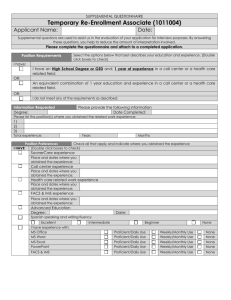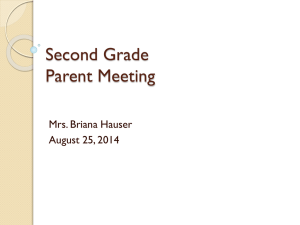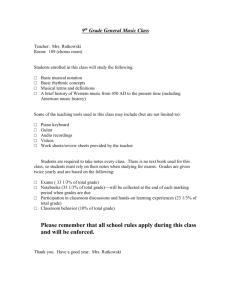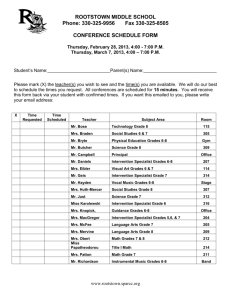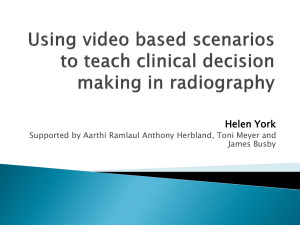Self-Paced Classroom Information
advertisement
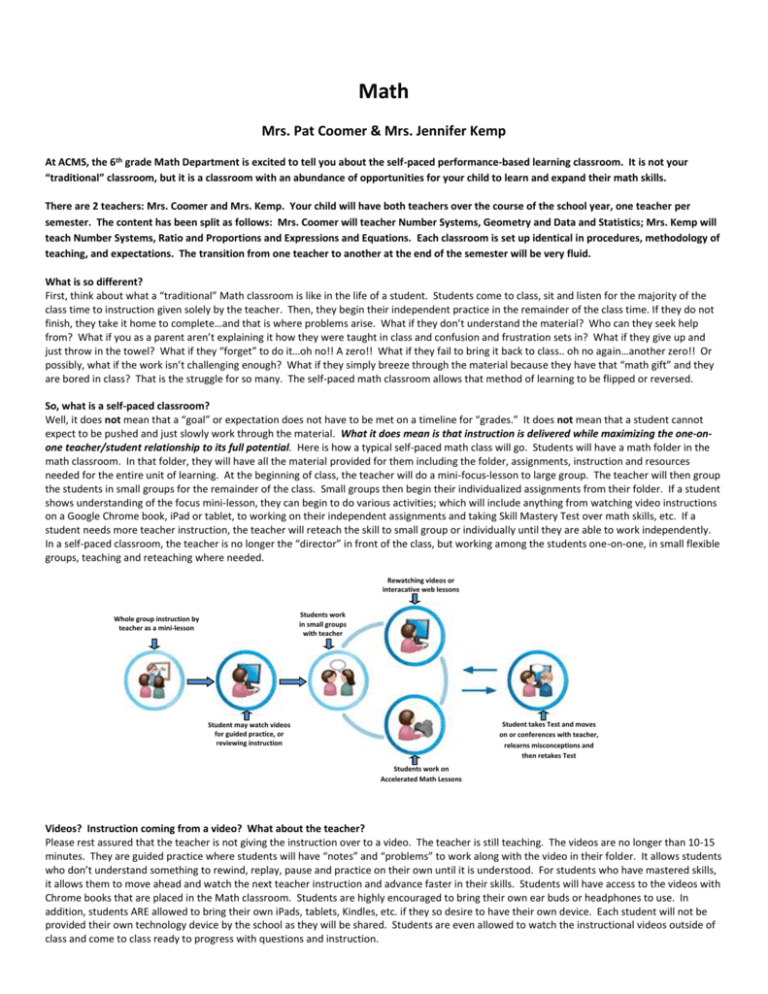
Math Mrs. Pat Coomer & Mrs. Jennifer Kemp At ACMS, the 6th grade Math Department is excited to tell you about the self-paced performance-based learning classroom. It is not your “traditional” classroom, but it is a classroom with an abundance of opportunities for your child to learn and expand their math skills. There are 2 teachers: Mrs. Coomer and Mrs. Kemp. Your child will have both teachers over the course of the school year, one teacher per semester. The content has been split as follows: Mrs. Coomer will teacher Number Systems, Geometry and Data and Statistics; Mrs. Kemp will teach Number Systems, Ratio and Proportions and Expressions and Equations. Each classroom is set up identical in procedures, methodology of teaching, and expectations. The transition from one teacher to another at the end of the semester will be very fluid. What is so different? First, think about what a “traditional” Math classroom is like in the life of a student. Students come to class, sit and listen for the majority of the class time to instruction given solely by the teacher. Then, they begin their independent practice in the remainder of the class time. If they do not finish, they take it home to complete…and that is where problems arise. What if they don’t understand the material? Who can they seek help from? What if you as a parent aren’t explaining it how they were taught in class and confusion and frustration sets in? What if they give up and just throw in the towel? What if they “forget” to do it…oh no!! A zero!! What if they fail to bring it back to class.. oh no again…another zero!! Or possibly, what if the work isn’t challenging enough? What if they simply breeze through the material because they have that “math gift” and they are bored in class? That is the struggle for so many. The self-paced math classroom allows that method of learning to be flipped or reversed. So, what is a self-paced classroom? Well, it does not mean that a “goal” or expectation does not have to be met on a timeline for “grades.” It does not mean that a student cannot expect to be pushed and just slowly work through the material. What it does mean is that instruction is delivered while maximizing the one-onone teacher/student relationship to its full potential. Here is how a typical self-paced math class will go. Students will have a math folder in the math classroom. In that folder, they will have all the material provided for them including the folder, assignments, instruction and resources needed for the entire unit of learning. At the beginning of class, the teacher will do a mini-focus-lesson to large group. The teacher will then group the students in small groups for the remainder of the class. Small groups then begin their individualized assignments from their folder. If a student shows understanding of the focus mini-lesson, they can begin to do various activities; which will include anything from watching video instructions on a Google Chrome book, iPad or tablet, to working on their independent assignments and taking Skill Mastery Test over math skills, etc. If a student needs more teacher instruction, the teacher will reteach the skill to small group or individually until they are able to work independently. In a self-paced classroom, the teacher is no longer the “director” in front of the class, but working among the students one-on-one, in small flexible groups, teaching and reteaching where needed. Rewatching videos or interacative web lessons Students work in small groups with teacher Whole group instruction by teacher as a mini-lesson Student takes Test and moves on or conferences with teacher, relearns misconceptions and then retakes Test Student may watch videos for guided practice, or reviewing instruction oreteaching Students work on Accelerated Math Lessons Videos? Instruction coming from a video? What about the teacher? Please rest assured that the teacher is not giving the instruction over to a video. The teacher is still teaching. The videos are no longer than 10-15 minutes. They are guided practice where students will have “notes” and “problems” to work along with the video in their folder. It allows students who don’t understand something to rewind, replay, pause and practice on their own until it is understood. For students who have mastered skills, it allows them to move ahead and watch the next teacher instruction and advance faster in their skills. Students will have access to the videos with Chrome books that are placed in the Math classroom. Students are highly encouraged to bring their own ear buds or headphones to use. In addition, students ARE allowed to bring their own iPads, tablets, Kindles, etc. if they so desire to have their own device. Each student will not be provided their own technology device by the school as they will be shared. Students are even allowed to watch the instructional videos outside of class and come to class ready to progress with questions and instruction. What about grades? The student is expected to work at a steady pace. The nine weeks cumulative grade will come from two areas: a weekly progress grade and test grade. That’s it! So, it is extremely important to progress efficiently, learn and master the math skills each day, and score proficient on tests. If a student does not make proficient (80% or above), they are allowed to have additional instruction and retake the test and replace any grade. Each student will have their own “track sheet” that is provided for them listing all the expectations for the week, as well as a tentative due date for the unit to be completed. As long as your child stays on track with the unit guide, he/she should be able to meet all deadlines. If they wish to move faster or need more school time, they are encouraged to stay after school on Early Release Fridays. If your child is falling behind in their selfpacing, you will be contacted by their Math teacher in hopes of quickly curtailing any issues that are forming. Below is a diagram example of how grades could be for typical students. Teacher instruction and expected due date. Student A – Working independently with instruction, small group and self-pacing. Student is able to move on to new unit with use of videos, one-on-one teacher instruction. Learning more than expected at a faster pace. Student is not prohibited by other classmates and teacher from moving on. Weekly grades are 100% because meeting weekly expectation of work and test grades are above proficient. Expected grade to earn - A Student B – Working at a steady pace, participates and uses time wisely, works some out of class. Student meets weekly deadline on independent practice and meeting unit expectations at due date. Test average is proficient. Expected grade to earn - A Student C – Working steady pace most of the time, but does not use class time wisely or use of teacher in small group. Does not meet weekly deadline expectation and is falling behind on their expected due date for unit. Parent will most likely be contacted by teacher, ERF recommended. If expectations are not meet weekly or below proficient on test, expected grade C, D or F. Deadline for unit Will there be homework? If a student is maximizing their class time and working to expectations, then paper/pencil homework assignments will be very minimal. However, if a student is having difficulty understanding material, not utilizing their class time for guided practice sessions, then yes, your child will need to have homework to meet deadlines and proficiency. On the other side of that, if you are wanting your child to succeed at a very high level, be extremely prepared for 7th and 8th grade math and high school courses, then your child could voluntarily watch videos and do “folder” work at home and move into higher level assignments. Please take advantage of “Parent Portal” on Infinite Campus so that you can monitor your child’s grades from home. With the Leader in Me Program at ACMS, students will be accessing their Infinite Campus pages as well. This will allow them to regularly monitor themselves and understand that they are “owners” of their grades and not something the teacher “gave” to them. +++++++++++++++++++++++++++++++++++++++++++++++++++++++++++++++++++++++++++++++++++++++++++++++++++++++++++ This is an exciting time in Adair County. Sixth grade Math is the first step for students on their path into pre-algebra at ACMS, college prep courses at ACHS, and college and career paths. If you have any questions, please feel free to contact your child’s math teacher as this is a combined effort in preparing our children for the road ahead.
